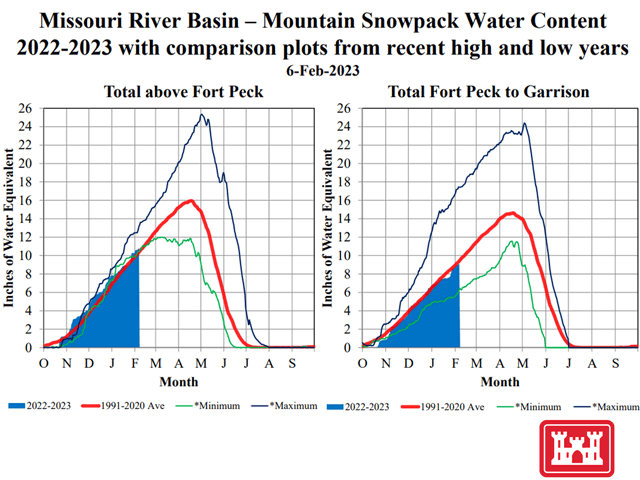Ag Weather Forum
Below-Average Runoff Forecast for Upper Missouri River in 2023
The 2022-23 winter season has brought some notable snowfall to the Northern Plains and Rocky Mountains. Measured snow depth in the first week of February was well over a foot in parts of the Northern Plains with some locations significantly greater. Northern Rockies snow depth was generally from 2 to 3 feet or more. This is much different than during the past couple winters when extreme drought covered much of the north-central U.S.
The aftereffect of the big drought means that much of the snowpack moisture is going to go into the soil profile to rebuild that supply. The result is that the runoff forecast for the Upper Missouri River basin, which covers the Dakotas and Montana, is for below-average runoff this year. An update news release from the U.S. Army Corps of Engineers authored by Eileen Williamson featured these details:
"Chief of the Corps' Missouri River Basin Water Management Division John Remus says drought conditions currently exist across most of the basin. He says despite January's runoff being above average the 2023 calendar year runoff forecast above Sioux City is 82% of average (21.1 million acre feet). The runoff forecast is based on current soil moisture conditions, plains snowpack, mountain snowpack and long-term precipitation and temperature outlooks." The Corps of Engineers update also notes that most of the region included in the Upper Missouri basin had below-average precipitation in January. The exception was southern South Dakota.
P[L1] D[0x0] M[300x250] OOP[F] ADUNIT[] T[]
The Corps runoff forecast update does note that snowpack in the Northern Plains is above average. Plains snowpack typically melts between February and April. Snow water equivalent moisture ranges from 2 to 4 inches in eastern Montana and the Dakotas, with up to 5 inches of snow water equivalent moisture in parts of the central and eastern Dakotas. However, snowpack moisture at the river above the Fort Peck, Montana reservoir (just over 10 inches) and the river stem from Fort Peck to Garrison, North Dakota (about 9 inches) are amounts that are about identical to the 30-year average.
A call for below-average runoff for the year from the Upper Missouri does make a difference in the amount of water that the Missouri can contribute to the Mississippi River. The Upper Missouri accounts for about 30% of the total Missouri River discharge at its mouth into the Mississippi. And the Missouri is the second-largest tributary of the Mississippi by volume, second only to the Ohio River. Long-range forecasts point to below-average precipitation during the spring and summer months in the Upper Missouri basin, suggesting that less-than-desired runoff from this source into the main U.S. agricultural transportation system will again be featured during the balance of the upcoming growing season.
The full Corps of Engineers release is available here: https://www.dvidshub.net/….
DTN's Mary Kennedy has a summary of the Mississippi River spring transportation outlook here: https://www.dtnpf.com/…
Bryce Anderson can be reached at Bryce.Anderson@dtn.com
Follow him on Twitter @BAndersonDTN
(c) Copyright 2023 DTN, LLC. All rights reserved.




